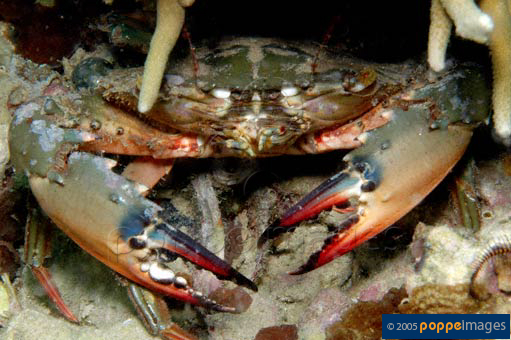| Portunidae (swimming crabs) |
| 7 cm CW (male/unsexed) |
|
benthopelagic; marine; depth range 0 - 50 m |
| Western Pacific: from Japan to Malaysia. Subtropical and tropical climates. |
|
Carapace without transverse ridges behind last anterolateral tooth; frontal teeth acutely triangular; anterolateral all acutely triangular. Posterior border of propodus of legs serrated. Palm with 5sharp spines, longitudinal ridges on palm granulated. Color: carapace white with large greyish patches, tips at anterolateral teeth reddish brown; fingers red and white. |
| Subtropical and tropical climates (Ref. 343). Found intertidal to subtidal, on substrates ranging from seagrass, mud, sand, to rocks. Occur to depths of 50 meters (Ref. 125642). Also found in tidepools on rocky shores (Ref. 118296). Common in estuaries, in firm or muddy fine sands (Ref. 118295). Generalist scavenger and predator (Ref. 118296). Benthopelagic predator, feeding mainly on benthic bivalves (Lamellibranchia), benthic crustaceans, fishes, and cephalopods (Ref. 117071). Host to the sacculinid barnacle Heterosaccus papillosus (Ref. 118296). |
|
Not Evaluated (N.E.) Ref. 123251)
|
|
|
Source and more info: www.sealifebase.org. For personal, classroom, and other internal use only. Not for publication.

